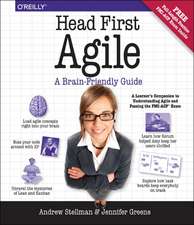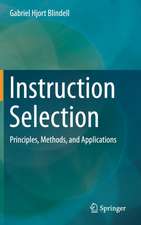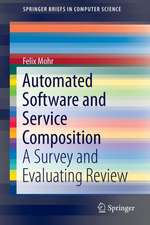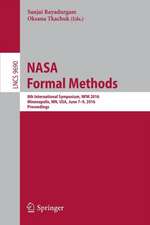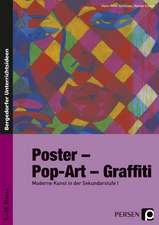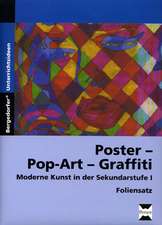UML @ Classroom: An Introduction to Object-Oriented Modeling: Undergraduate Topics in Computer Science
Autor Martina Seidl, Marion Scholz, Christian Huemer, Gerti Kappelen Limba Engleză Paperback – 9 mar 2015
After a brief explanation of why modeling is an indispensable part of software development, the authors introduce the individual diagram types of UML (the class and object diagram, the sequence diagram, the state machine diagram, the activity diagram, and the use case diagram), as well as their interrelationships, in a step-by-step manner. The topics covered include not only the syntax and the semantics of the individual language elements, but also pragmatic aspects, i.e., how to use them wisely at various stages in the software development process. To this end, the work is complemented with examples that were carefully selected for their educational and illustrative value.
Overall, the book provides a solid foundation and deeper understanding of the most important object-oriented modeling concepts and their application in software development. An additional website offers a complete set of slides to aid in teaching the contents of the book, exercises and further e-learning material.
Din seria Undergraduate Topics in Computer Science
- 20%
 Preț: 304.13 lei
Preț: 304.13 lei - 20%
 Preț: 233.75 lei
Preț: 233.75 lei - 20%
 Preț: 350.89 lei
Preț: 350.89 lei - 20%
 Preț: 306.58 lei
Preț: 306.58 lei - 20%
 Preț: 187.22 lei
Preț: 187.22 lei - 20%
 Preț: 272.43 lei
Preț: 272.43 lei - 20%
 Preț: 280.93 lei
Preț: 280.93 lei - 20%
 Preț: 245.43 lei
Preț: 245.43 lei - 20%
 Preț: 305.61 lei
Preț: 305.61 lei - 20%
 Preț: 258.79 lei
Preț: 258.79 lei - 20%
 Preț: 376.76 lei
Preț: 376.76 lei - 20%
 Preț: 246.39 lei
Preț: 246.39 lei - 20%
 Preț: 336.99 lei
Preț: 336.99 lei - 20%
 Preț: 341.22 lei
Preț: 341.22 lei - 20%
 Preț: 192.73 lei
Preț: 192.73 lei - 20%
 Preț: 306.72 lei
Preț: 306.72 lei - 20%
 Preț: 384.11 lei
Preț: 384.11 lei - 20%
 Preț: 316.07 lei
Preț: 316.07 lei - 20%
 Preț: 374.37 lei
Preț: 374.37 lei - 20%
 Preț: 225.03 lei
Preț: 225.03 lei - 20%
 Preț: 226.65 lei
Preț: 226.65 lei - 20%
 Preț: 375.54 lei
Preț: 375.54 lei - 20%
 Preț: 307.17 lei
Preț: 307.17 lei - 20%
 Preț: 254.37 lei
Preț: 254.37 lei -
 Preț: 334.89 lei
Preț: 334.89 lei - 20%
 Preț: 227.16 lei
Preț: 227.16 lei - 20%
 Preț: 304.37 lei
Preț: 304.37 lei - 20%
 Preț: 316.24 lei
Preț: 316.24 lei - 20%
 Preț: 287.03 lei
Preț: 287.03 lei - 20%
 Preț: 342.46 lei
Preț: 342.46 lei - 20%
 Preț: 276.82 lei
Preț: 276.82 lei - 20%
 Preț: 237.35 lei
Preț: 237.35 lei - 20%
 Preț: 374.20 lei
Preț: 374.20 lei - 20%
 Preț: 304.44 lei
Preț: 304.44 lei - 20%
 Preț: 297.28 lei
Preț: 297.28 lei - 20%
 Preț: 579.37 lei
Preț: 579.37 lei - 20%
 Preț: 298.18 lei
Preț: 298.18 lei - 20%
 Preț: 243.35 lei
Preț: 243.35 lei - 20%
 Preț: 302.80 lei
Preț: 302.80 lei - 20%
 Preț: 297.66 lei
Preț: 297.66 lei - 20%
 Preț: 300.89 lei
Preț: 300.89 lei - 20%
 Preț: 191.36 lei
Preț: 191.36 lei - 20%
 Preț: 278.11 lei
Preț: 278.11 lei - 20%
 Preț: 304.21 lei
Preț: 304.21 lei - 20%
 Preț: 389.96 lei
Preț: 389.96 lei
Preț: 395.05 lei
Preț vechi: 493.82 lei
-20% Nou
Puncte Express: 593
Preț estimativ în valută:
75.62€ • 82.16$ • 63.56£
75.62€ • 82.16$ • 63.56£
Carte disponibilă
Livrare economică 31 martie-14 aprilie
Livrare express 15-21 martie pentru 154.77 lei
Preluare comenzi: 021 569.72.76
Specificații
ISBN-13: 9783319127415
ISBN-10: 3319127411
Pagini: 240
Ilustrații: XII, 206 p.
Dimensiuni: 168 x 240 x 17 mm
Greutate: 3.77 kg
Ediția:2015
Editura: Springer International Publishing
Colecția Springer
Seria Undergraduate Topics in Computer Science
Locul publicării:Cham, Switzerland
ISBN-10: 3319127411
Pagini: 240
Ilustrații: XII, 206 p.
Dimensiuni: 168 x 240 x 17 mm
Greutate: 3.77 kg
Ediția:2015
Editura: Springer International Publishing
Colecția Springer
Seria Undergraduate Topics in Computer Science
Locul publicării:Cham, Switzerland
Public țintă
Lower undergraduateCuprins
1 Introduction.- 2 A Short Tour of UML.- 3 The Use Case Diagram.- 4 The Class Diagram.- 5 The State Machine Diagram.- 6 The Sequence Diagram.- 7 The Activity Diagram.- 8 All Together Now.- 9 Further Topics.
Notă biografică
Martina Seidl is assistant professor at the Institute for Formal Models and Verification at the Johannes Kepler University Linz and research associate of the Business Informatics Group of the Vienna University of Technology. Her research focuses on formal methods in modeling, model evolution as well as different aspects of automated theorem proving. She has been involved in teaching numerous courses for all stages of the computer science curricula in Vienna and Linz, many of them directly related to her research.
Marion Scholz studied computer science at the Vienna University of Technology and at the University of Vienna. Since 2007 she teaches object-oriented modeling to first year bachelor students studying computer science and business informatics. As a senior lecturer, her research interests are new teaching methods with a strong focus on e-learning technologies. One of her main challenges is raising the quality of teaching despite large numbers of students.
Christian Huemer is associate professor in the Business Informatics Group of the Vienna University of Technology and serves as vice-dean of academic affairs for business informatics. In addition, he is Scientific Director of the Research Centre Smart Agent Technologies of Research Studios Austria. For ten years he was Chair of the Techniques & Methodologies Group of the United Nations Centre for Trade Facilitation and e-Business (UN / CEFACT). In particular, he has been the project lead of UN / CEFACT Modeling Methodology (UMM) - a UML profile for the specification of inter-organizational business processes.
Gerti Kappel is a full professor at the Institute of Software Technology and Interactive Systems at the Vienna University of Technology, chairing the Business Informatics Group. She is head of the Doctoral College “Adaptive Distributed Systems”, funded by Vienna University of Technology. Her current research interests include model engineering (model transformation/versioning/evolution, model-driven software development, object-oriented modeling), Web engineering (ubiquitous Web technologies, context awareness, information integration, model-driven development), and process engineering (process modeling, inter-organizational systems, workflow systems).
Marion Scholz studied computer science at the Vienna University of Technology and at the University of Vienna. Since 2007 she teaches object-oriented modeling to first year bachelor students studying computer science and business informatics. As a senior lecturer, her research interests are new teaching methods with a strong focus on e-learning technologies. One of her main challenges is raising the quality of teaching despite large numbers of students.
Christian Huemer is associate professor in the Business Informatics Group of the Vienna University of Technology and serves as vice-dean of academic affairs for business informatics. In addition, he is Scientific Director of the Research Centre Smart Agent Technologies of Research Studios Austria. For ten years he was Chair of the Techniques & Methodologies Group of the United Nations Centre for Trade Facilitation and e-Business (UN / CEFACT). In particular, he has been the project lead of UN / CEFACT Modeling Methodology (UMM) - a UML profile for the specification of inter-organizational business processes.
Gerti Kappel is a full professor at the Institute of Software Technology and Interactive Systems at the Vienna University of Technology, chairing the Business Informatics Group. She is head of the Doctoral College “Adaptive Distributed Systems”, funded by Vienna University of Technology. Her current research interests include model engineering (model transformation/versioning/evolution, model-driven software development, object-oriented modeling), Web engineering (ubiquitous Web technologies, context awareness, information integration, model-driven development), and process engineering (process modeling, inter-organizational systems, workflow systems).
Textul de pe ultima copertă
This textbook mainly addresses beginners and readers with a basic knowledge of object-oriented programming languages like Java or C#, but with little or no modeling or software engineering experience – thus reflecting the majority of students in introductory courses at universities. Using UML, it introduces basic modeling concepts in a highly precise manner, while refraining from the interpretation of rare special cases.
After a brief explanation of why modeling is an indispensable part of software development, the authors introduce the individual diagram types of UML (the class and object diagram, the sequence diagram, the state machine diagram, the activity diagram, and the use case diagram), as well as their interrelationships, in a step-by-step manner. The topics covered include not only the syntax and the semantics of the individual language elements, but also pragmatic aspects, i.e., how to use them wisely at various stages in the software development process. To this end, the work is complemented with examples that were carefully selected for their educational and illustrative value.
Overall, the book provides a solid foundation and deeper understanding of the most important object-oriented modeling concepts and their application in software development. An additional website offers a complete set of slides to aid in teaching the contents of the book, exercises and further e-learning material.
After a brief explanation of why modeling is an indispensable part of software development, the authors introduce the individual diagram types of UML (the class and object diagram, the sequence diagram, the state machine diagram, the activity diagram, and the use case diagram), as well as their interrelationships, in a step-by-step manner. The topics covered include not only the syntax and the semantics of the individual language elements, but also pragmatic aspects, i.e., how to use them wisely at various stages in the software development process. To this end, the work is complemented with examples that were carefully selected for their educational and illustrative value.
Overall, the book provides a solid foundation and deeper understanding of the most important object-oriented modeling concepts and their application in software development. An additional website offers a complete set of slides to aid in teaching the contents of the book, exercises and further e-learning material.
Caracteristici
Describes not only syntax and semantics of UML elements, but also how to use them wisely in the software development process Contains lots of carefully selected examples to illustrate the usage of the various UML diagram types Complemented by a Web site with teaching slides, video lectures, exercises, and further teaching material Includes supplementary material: sn.pub/extras









